Top speed 1,814 km/h Length 17 m Engine type General Electric F404 | Range 3,330 km Introduced 7 January 1983 | |
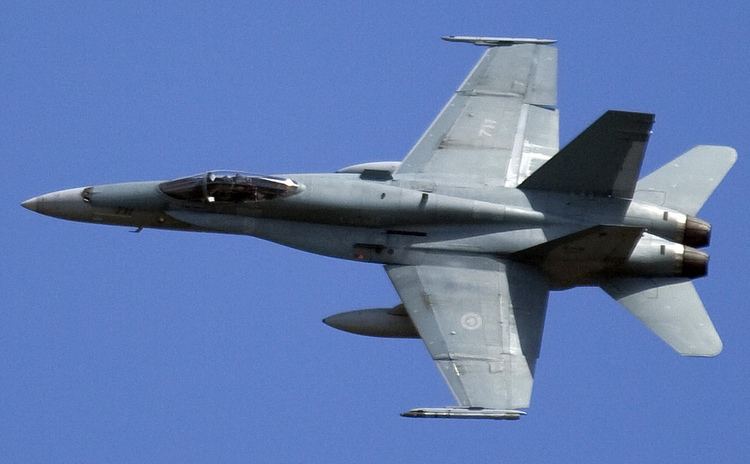 | ||
Unit cost 35,000,000–35,000,000 USD (1977) | ||
2014 abbotsford airshow mcdonnell douglas cf 18 hornet demo day show
The McDonnell Douglas CF-18 Hornet (official military designation CF-188) is a Royal Canadian Air Force (RCAF) (formerly Canadian Forces Air Command) fighter aircraft, based on the American McDonnell Douglas F/A-18 Hornet fighter. In 1980, the F/A-18 was selected as the winner of the New Fighter Aircraft Project competition, and a production order was awarded. The Canadian Forces began receiving the CF-18 in 1982. CF-18s have supported North American Aerospace Defense Command (NORAD) air sovereignty patrols and participated in combat during the Gulf War in 1991, the Kosovo War in the late 1990s, and as part of the Canadian contribution to the international Libyan no-fly zone in 2011. CF-18s were also part of the Canadian contribution to the Military intervention against ISIL, Operation Impact.
Contents
- 2014 abbotsford airshow mcdonnell douglas cf 18 hornet demo day show
- New Fighter Aircraft program
- CF 18 design changes
- Upgrades
- Entering service
- Combat
- Replacement
- Variants
- Operators
- Losses
- Specifications CF 18
- Notable appearances in media
- References

New Fighter Aircraft program
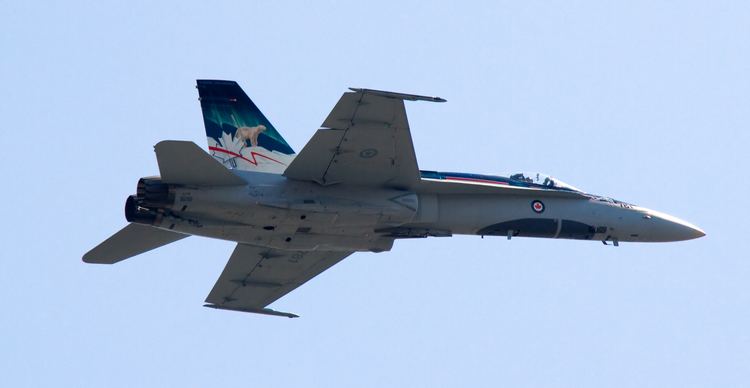
In 1977, the Canadian government identified the need to replace the NATO-assigned CF-104 Starfighter, the NORAD-assigned CF-101 Voodoo and the CF-116 Freedom Fighter (although the decision was later made to keep the CF-116). Subsequently, the government proceeded with the New Fighter Aircraft (NFA) competition, with a purchase budget of around C$2.4 billion to purchase 130–150 of the winner of the competition. Candidates included the Grumman F-14 Tomcat, McDonnell Douglas F-15 Eagle, Panavia Tornado, Dassault Mirage F1 (later replaced by the Mirage 2000), plus the products of the American Lightweight Fighter (LWF) competition, the General Dynamics F-16 Fighting Falcon, the F/A-18 Hornet, and a de-navalized version of the Hornet, the F-18L. The government stressed that the winner of the competition be a proven off-the-shelf design and provide substantial industrial benefits as part of the order.
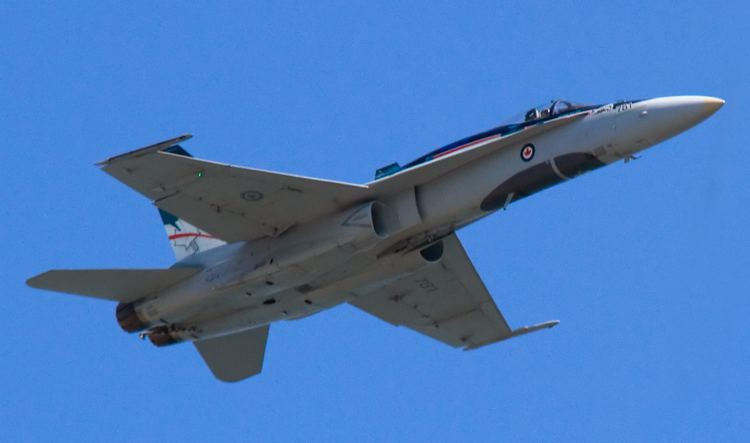
By 1978, the New Fighter Aircraft competitors were short-listed to just three aircraft types: the F-16 and the two F-18 offerings. The F-14, F-15, and the Tornado were rejected due to their high purchase price, while Dassault dropped out of the competition. The F-18L combined the systems and twin-engine layout of the F-18 that Air Command favored with a lighter land-based equipment setup that significantly improved performance. Northrop, the primary contractor for the F-18L version, had not built the aircraft by the time of the NFA program, waiting on successful contracts before doing so. While Northrop offered the best industrial offset package, it would only "pay off" if other F-18L orders were forthcoming, something the Department of National Defence (DND) was not willing to bet on.
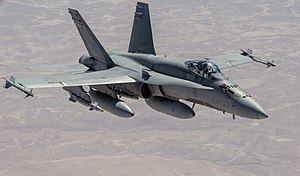
The F-14 almost entered Canadian service through the backdoor due to the Iranian Revolution. In the aftermath of the revolution, the United States cut off all military supplies to Iran, which meant that the Iranians' new fleet of F-14s would potentially be rendered unflyable due to a lack of spares. The Canadians offered to purchase them at a steeply discounted price. Negotiations ended before a deal was reached as it was revealed that Canadian involvement was crucial in the smuggling of American embassy personnel out of the new Islamic Republic.
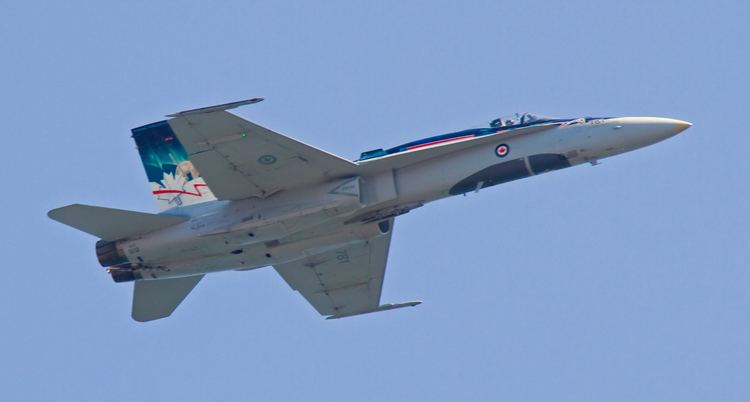
In 1980, the McDonnell Douglas F/A-18 Hornet was declared the winner of the New Fighter Aircraft competition. The order included 98 single-seat variants and 40 dual-seat variants, for a total of 138 purchased, plus 20 options (which were not exercised). The F/A-18 Hornet was then dubbed the CF-188. In every context except the most official of military documents, the aircraft are referred to as CF-18 Hornets. Reasons for the selection listed by the Canadian Forces were many of its requested features were included for the U.S. Navy; two engines for reliability (considered essential for conducting Arctic sovereignty and over-the-water patrols), an excellent radar set, while being considerably more affordable than the F-14 and the F-15. The CF-18 was procured from 1982 to 1988, at a total capital cost of $4 billion in 1982 dollars.
CF-18 design changes
The original CF-18 as delivered is largely identical to the F/A-18A and B models. 80 CF-18s, consisting of 62 single-seat and 18 dual-seat models. Many features that made the F/A-18 suitable for naval carrier operations were retained by the Canadian Forces, such as the robust landing gear, the arrestor hook, and wing folding mechanisms.
The most visible difference between a CF-18 and a U.S. F-18 is the 0.6 Mcd night identification light. This spotlight is mounted in the gun loading door on the port side of the aircraft. Some CF-18s have the light temporarily removed, but the window is always in place. Also, the underside of the CF-18 features a painted "false canopy". This is intended to momentarily disorient and confuse an enemy in air-to-air combat. Subsequently, the U.S. Marine Corps Aviation and the Spanish Air Force F/A-18s also adopted this false canopy.
Upgrades
The need to upgrade the CF-18 was demonstrated during the Gulf War I deployment and during the 1998 Kosovo conflict as advances in technology had rendered some of the avionics on board the CF-18 obsolete and incompatible with NATO allies. In 2000, CF-18 upgrades became possible when the government increased the defence budget.
In 2001, the Incremental Modernization Project (IMP) was initiated. The project was broken into two phases over a period of eight years and was designed to improve air-to-air and air-to-ground combat capabilities, upgrade sensors and the defensive suite, and replace the datalinks and communications systems on board the CF-18 from the old F/A-18A and F/A-18B standard to the current F/A-18C and D standard. Boeing (merged with McDonnell Douglas) the primary contractor and L-3 Communications the primary subcontractor, was issued a contract for the modernization project starting in 2002. A total of 80 CF-18s, consisting of 62 single-seat and 18 dual-seat models were selected from the fleet for the upgrade program. The project is supposed to extend the life of the CF-18 until around 2017 to 2020.
Within the same time frame, other non-IMP upgrades include:
The first completed "Phase I" CF-18 was delivered to the Canadian Forces on time in May 2003. Final delivery of all "Phase I" CF-18s was done at a ceremony on 31 August 2006 at L-3 Communications in Mirabel, Quebec.
Phase II of the CF-18 Incremental Modernization Project was awarded to Boeing on 22 February 2005. It consists of the following upgrades:
Within the same time frame, other non-IMP upgrades include:
The first completed "Phase II" CF-18 was delivered to the Canadian Forces on 20 August 2007, at a ceremony in Montreal. The total cost of the entire CF-18 Incremental Modernization Project and concurrent Hornet upgrades was expected to be around C$2.6 billion. The final upgraded aircraft was delivered in March 2010.
The total program cost for the CF-18 purchase and upgrade programs is approximately $11.5 billion including upgrades, in 2011 dollars. Additionally, the cost of maintenance for any 20-year period has been approximately $5 billion, or $250 million per year.
Entering service
The first two CF-18s were formally handed over to 410 (Operational Training Unit) Squadron at CFB Cold Lake, Alberta on 25 October 1982. Further deliveries equipped 409, 439, and 421 Squadrons at Baden-Soellingen in then West Germany, the 410 Operation Training Unit, No. 416, and No. 441 Squadrons at Cold Lake, and 425 and 433 Escadrilles (Squadrons) at CFB Bagotville, Quebec. Introduction into Canadian service was initially problematic due to early issues with structural fatigue which delayed initial deployment. As the initial bugs were worked out, the CF-18 started filling the NORAD interception and NATO roles as intended.
Combat
In 1991, Canada committed 26 CF-18s to the Gulf War on Operation Friction. The CF-18s were based in Doha, Qatar. During the Gulf War, Canadian pilots flew more than 5,700 hours, including 2,700 combat air patrol missions. These aircraft were taken from Canada's airbase in Germany, CFB Baden-Soellingen. In the beginning the CF-18s began sweep-and-escort combat missions to support ground-attack strikes by Allied air forces. During the 100-hour Allied ground invasion in late February, CF-18s also flew 56 bombing sorties, mainly dropping 500 lb (230 kg) non-guided ("dumb") bombs on Iraqi artillery positions, supply dumps, and marshaling areas behind the lines. At the time the Canadian Hornets were unable to deploy precision guided munitions. This was the first time since the Korean War that the Canadian military had participated in combat operations.
Continuing violence in the former Yugoslavia brought CF-18s into theatre twice: first for a deployment (Operation Mirador) during August–November 1997 for air patrols supporting NATO peacekeepers in Bosnia and Herzegovina, and again from late June 1998 until late December 2000 (Operation Echo).
From March to June 1999, with 18 CF-18s already deployed to Aviano, Italy, Canada participated in both the air-to-ground and air-to-air roles. Canadian aircraft conducted 10 percent of the NATO strike sorties despite deploying a much smaller percentage of the overall forces. Canadian pilots flew 678 combat sorties: 120 defensive counter-air escorts for Allied strike packages and 558 bombing strikes during 2,577 combat flying hours. CF-18s dropped a total of 397 PGMs and 171 non-guided bombs on a wide variety of targets including surface-to-air missile sites, airfields, bridges and fuel storage areas.
Since 2001, CF-18s have responded to nearly 3,000 possible threats to Canada and United States. A task group of CF-18s and CH-146 Griffons were deployed during "Operation Grizzly" to Kananaskis, Alberta in June 2002 where they were deployed to secure the airspace during the 28th G8 summit. In 2007, an unknown number of CF-18s were deployed to Alaska. They were deployed during two weeks to defend United States airspace as a result of the primary USAF F-15 fighter jet fleet being grounded due to structural defects. They were also deployed during "Operation Podium" to secure the 2010 Winter Olympics and 2010 Winter Paralympics games.
After a United Nations Security Council resolution was adopted to enforce a Libyan no-fly zone, the Government of Canada on 18 March 2011, authorized the deployment of six CF-18 Hornets with one Hornet in reserve as part of Operation Mobile. The Hornets were based at Trapani-Birgi Italian Air Force base in western Sicily. CF-18s were first put into combat on 23 March 2011 when four aircraft bombed Libyan government targets. The seven Hornets returned to CFB Bagotville, Canada, on 4 November 2011 after the end of the UN-approved NATO mission. In total, the Hornets conducted 946 sorties, making up 10% of NATO strike sorties. Over the course of their sorties, 696 bombs were dropped including Laser-guided bombs and Joint Direct Attack Munitions (JDAM). The RCAF has dropped 495 of the 227 kg versions (500 lbs) and 188 of the 910 kg versions (2,000 lbs) Paveway II bombs. The RCAF also dropped 11 Joint Direct Attack Munitions of the 227 kg versions and two 910 kg versions.
Canada sent six CF-18s to Iraq as part of Operation Impact on 21 October 2014. Air strikes on ISIS/ISIL positions began on 2 November 2014. The CF-18s flew air strike missions until 15 February 2016.
During 2013-2014, the CF-18 fleet escorted at least 24 Tupolev Tu-95 Russian Bombers, at least 1 Ilyushin Il-20 surveillance aircraft, 2 MiG-31s and 9 MiG-29s out of Canadian Arctic Airspace, Baltic Airspace and American Arctic Airspace.
Replacement
Various fighter aircraft have been considered by the Canadian Forces as replacements for the CF-18, with the Lockheed Martin F-35 Lightning II, Eurofighter Typhoon, Saab JAS 39 Gripen, Dassault Rafale, and the Boeing F/A-18E/F Super Hornet all having been promoted as contenders by their manufacturers. According to Le Devoir, project costs without considering maintenance, training and spare parts, were estimated at $4 to $8 billion.
Boeing indicated that the F/A-18E/F Super Hornet, a derivative of the F/A-18 Hornet, was a less expensive alternative at an estimated total cost of $4 billion. One of the manufacturers in contention, Boeing, BAE Systems or Saab Aerospace—the name was not disclosed—had promised to assemble the entire aircraft in Canada although. Boeing said that it was contemplating shutting down production of the F/A-18 fighter production line due to lack of orders.
In July 2010 the Canadian government announced that the F-35 Lightning II would replace the CF-18. Canada has been a partner in the Joint Strike Fighter program since 1997, and a Tier 3 partner for the F-35 Lightning II since 2002. The Canadian Forces planned to buy 65 F-35s with deliveries starting in 2016; the contract was estimated to be worth C$9 billion, including aircraft and associated weapons, infrastructure, initial spares, training simulators, contingency funds and project operating costs. Media reports indicated that the lifetime cost of the aircraft might be as high as C$40 billion. In December 2012 it was announced that the government had abandoned the F-35 deal due to escalating cost, and was beginning a new procurement process, with the F-35 still being considered.
On 20 September 2015 Canadian Liberal Party leader Justin Trudeau promised to cancel the country's F-35 procurement plan if he were elected, instead replacing Canada's ageing fleet of CF-18s with a less costly alternative, arguing that the F-35 was not needed to defend Canada. He was sworn in as Prime Minister on 4 November 2015. On November 22, 2016, the Liberal government announced the purchase of 18 Boeing Super Hornet fighter jets to fill a "capability gap" as a stop-gap measure until new jets could be properly sourced and purchased, a process that could take up to five years according to Defence Minister Harjit Sajjan.
Variants
Operators
Rotations from Cold Lake occur from 4 Wing to CFB Comox, British Columbia and from 3 Wing Bagotville to CFB Goose Bay and CFB Gander, Newfoundland and Labrador, CFB Greenwood, Nova Scotia, and various forward operating bases in the Canadian Arctic. There are normally a few aircraft at CFB Trenton, Ontario as well, though not a permanent squadron.
Losses
Canada has lost at least twenty CF-18s in accidents, incurring at least eleven pilot deaths, as of November 28, 2016. Other accidents damaged aircraft and injured pilots.
Losses include:
Specifications (CF-18)
Data from CF-18 Specifications
General characteristics
Performance
Armament
Avionics
Notable appearances in media
The documentary television show Jetstream, which aired on Discovery Channel Canada, followed eight pilots training with the Canadian air force to fly the CF-18 at CFB Cold Lake. They trained in 410 Tactical Fighter Training Squadron.
The CF-18 is used as a primary element of the new logo for the Winnipeg Jets NHL hockey team, as an homage to the city's connection to the RCAF/CF as well as an earlier Olympic gold medal winning team, the Ottawa RCAF Flyers. The official unveiling described the origin of the design involving the cooperation of the Department of National Defence and was inspired by the logo of the Royal Canadian Air Force. Team spokesman Dorian Morphy, Senior Director, Marketing & Brand Management of True North Sports & Entertainment indicated, "We are thrilled to be able to continue this relationship in a significant way. The design cues for the plane were inspired by the military jets flown by the Air Force over the years."
